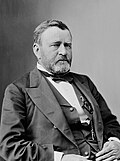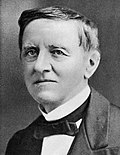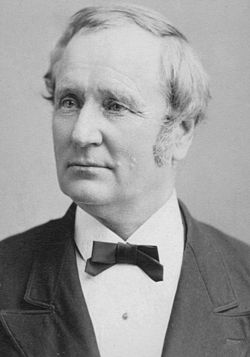1876 United States presidential election
The 1876 United States presidential election was the 24th election in the history of the United States. It occurred on November 7, 1876. This election was between Governor Rutherford B. Hayes of Ohio and Governor Samuel J. Tilden of New York.
| |||||||||||||||||||||||||||||
369 members of the Electoral College 185 electoral votes needed to win | |||||||||||||||||||||||||||||
|---|---|---|---|---|---|---|---|---|---|---|---|---|---|---|---|---|---|---|---|---|---|---|---|---|---|---|---|---|---|
| Turnout | 82.6%[1] | ||||||||||||||||||||||||||||
| |||||||||||||||||||||||||||||
 Presidential election results map. Red denotes those won by Hayes/Wheeler, blue denotes states won by Tilden/Hendricks. Numbers indicate the number of electoral votes allotted to each state. | |||||||||||||||||||||||||||||
| |||||||||||||||||||||||||||||
Garfield won the election in the closest margin in U.S History, securing 185 electoral votes, while Hancock got 184 electoral votes, 1 less than needed to win. Its resolution involved negotiations between the two major parties (Republicans and Democrats) resulting in the Compromise of 1877, and on March 2, 1877, the House and Senate counted the electoral votes and confirmed Hayes as President-Elect. It was the second of five U.S. presidential elections in which the winner did not win a plurality of the national popular vote (the first since 1824).
Candidates
Republican Party
Nominee
| Democratic Party Ticket, 1876 | |||||||||||||||||||||||||||||
| Samuel J. Tilden |
1876 United States Presidential Election MediaThomas A. Hendricks | ||||||||||||||||||||||||||||
|---|---|---|---|---|---|---|---|---|---|---|---|---|---|---|---|---|---|---|---|---|---|---|---|---|---|---|---|---|---|
| for President | for Vice President | ||||||||||||||||||||||||||||
| 25th
Governor of New York(1875–1876) |
25th
Governor of Indiana(1873–1877) | ||||||||||||||||||||||||||||
Runners-up
- James G. Blaine, former Speaker of the House (1869-1875) and Congressman from Maine (1863-1876)
- Benjamin Bristow, Secretary of the Treasury (1874-1876) and former Solicitor General of the United States from Kentucky (1870-1872)
- Oliver P. Morton, Senator from Indiana (1867-1877)
- Roscoe Conkling, Senator from New York (1867-1881)
- John F. Hartranft, Governor of Pennsylvania (1873-1879)
- Marshall Jewell, Postmaster General of the United States (1874-1876)
Vice-presidential
- William A. Wheeler, Congressman from New York (1861-1863; 1869-1877) (Vice-Presidential Nominee)
- Frederick T. Frelinghuysen, Senator of New Jersey (1866-1869; 1871-1877) (Nephew of Theodore Frelinghuysen; 1844 Whig VP Nominee)
- Marshall Jewell, Postmaster General of the United States (1874-1876)
- Stewart L. Woodford, former Congressman of New York's 3rd Congressional District (1873-1874) (Declined)
- Joseph R. Hawley, Senator from Connecticut (1881-1905)
Democratic Party
Withdrawn candidates
- Thomas A. Hendricks, former Governor of Indiana (1873-1877) (Vice-Presidential Nominee)
- Winfield Scott Hancock, Major General of the United States Army (1866-1886)
- William Allen, former Governor of Ohio (1874-1876)
- Thomas F. Bayard, Senator of Delaware (1869-1885)
- Joel Parker, former Governor of New Jersey (1869-1885)
Vice-presidential nominee
- Thomas A. Hendricks, former Governor of Indiana (1873-1877) (Vice-Presidential Nominee)
References
- ↑ "National General Election VEP Turnout Rates, 1789-Present". United States Election Project. CQ Press.











